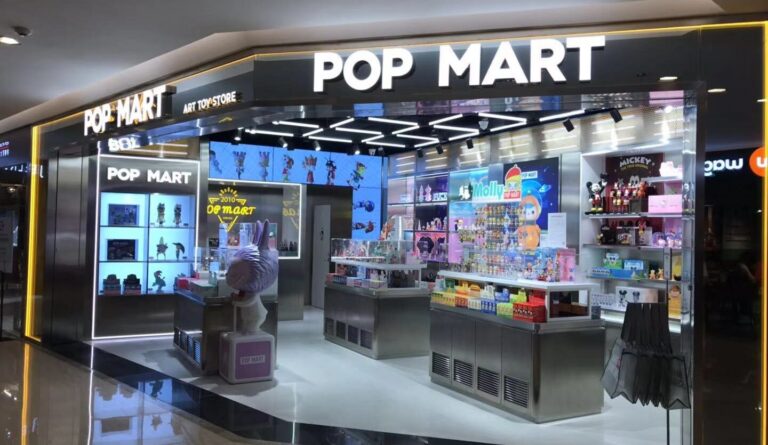The Chinese retail industry is reaping the benefits of China’s economic growth. But domestic e-commerce has become saturated and stagnant. The industry is now moving towards “New Retail” to find a new room to grow. The concept of new retail in China is the merge online and offline retail, eliminating the data boundaries between different retailing channels. By integrating AI in new retail in China, retailers can find a better way to improve business efficiency, as well as provide a holistic shopping experience for customers.
Unmanned stores in China: Integrating AI technologies in Chinese retail
As the first emerging store-model after the new retail concept was proposed, China’s unmanned stores started sprouting up in China starting in 2017. According to iResearch, the market size of unmanned stores is expected to exceed 3.3 billion in 2020. At this stage, AI technologies in Chinese unmanned retail are mainly divided into three categories: bar codes, radio frequency identification devices (RFID), and machine vision. The following are the major technologies of leading enterprises among unmanned stores in China:
QR codes
The QR code, in other words, the two-dimensional code, provides information storage on both horizontal and vertical axes. It enables consumers to pay for goods by scanning codes on the products. It’s fundamental to unmanned stores with the advantages of lower costs and quick payment. Small unmanned stores such as Bianlifeng and Xiao E micro shop use this technique.
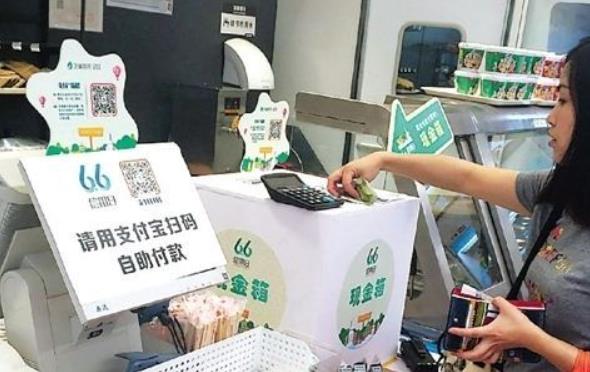
Radio Frequency Identification Devices (RFID)
RFID is relatively mature in using electromagnetic fields to automatically identify and track items’ tags. It requires sellers to stick RFID tags on each product to improve the efficiency of identifying goods.
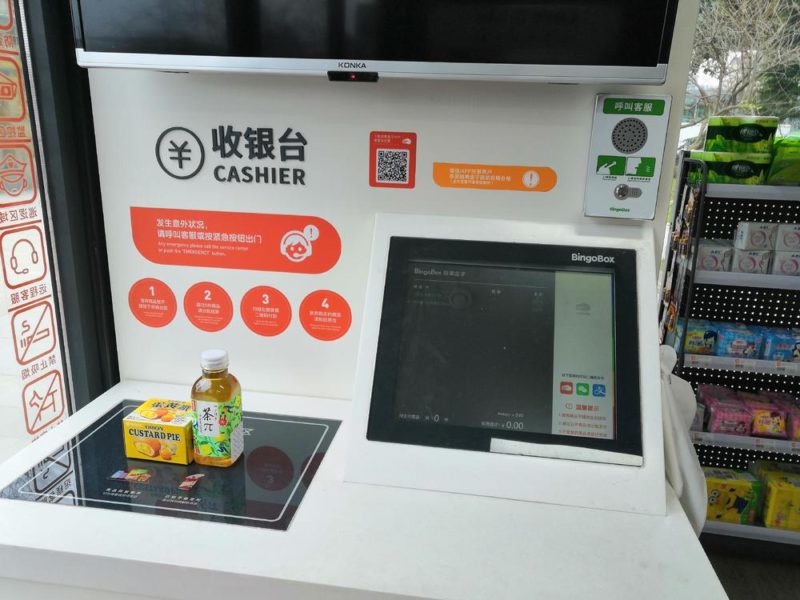
Machine Vision
Machine vision uses cameras and computers for facial and behavior recognition. Presently in China’s unmanned stores, machine vision performs as a store clerk to recognize and trace customer behavior.

However, unmanned stores in China have started experiencing a series of closures, bottlenecking further development. One major obstacle is the difficulty of selling fresh groceries in the store without adding staff. Customers expect to buy processed food when in convenience stores. Some unmanned stores that only carry long-lasting products like drinks and snacks would not attract consumers but only be regarded as a big vending machine.
By analyzing Tao Café and Bingo Box, the most recognized unmanned stores in China, it can be seen that they can significantly enhance the shopping experience. Customers can enter Tao Café and Bingo Box by scanning QR codes on their apps. The stores are equipped with biometric systems and machine vision technologies used for facial and speech recognition. With further upgrades of AI technologies in Chinese retail, Tao Café can track target consumers, analyze what the consumer took as they leave the store, and offer speedy payment procedures, effectively removing the need of a check-out system.
From unmanned stores to smart stores: How AI applications in China have changed the retail landscape
AI is being applied in new ways across the entire new retail product and service cycle, from assembly to customer service interactions. Integrating AI in new retail is helping retailers discover actionable insights with different AI applications. For the perception of the retail process, AI applications in China’s new retail can be broken down into the categories as below:
Customer traffic recognition
The traditional Chinese retail industry lacks effective means to understand consumers’ needs and purchasing habits. Customer traffic recognition is one of the solutions of using AI technologies in Chinese retail. Tech companies support AI technologies in Chinese retail Hikvision and Winner Technology.
Customer traffic recognition can identify the flow density of consumers in the store and draw a heat map through real-time monitoring, thereby calculating the most popular goods and services to understand consumer’s shopping habits. Through the results, operation settings of the store can be adjusted timely. Also, it allows retailers to keep the optimal configuration and realize the balance between people, goods, and places.
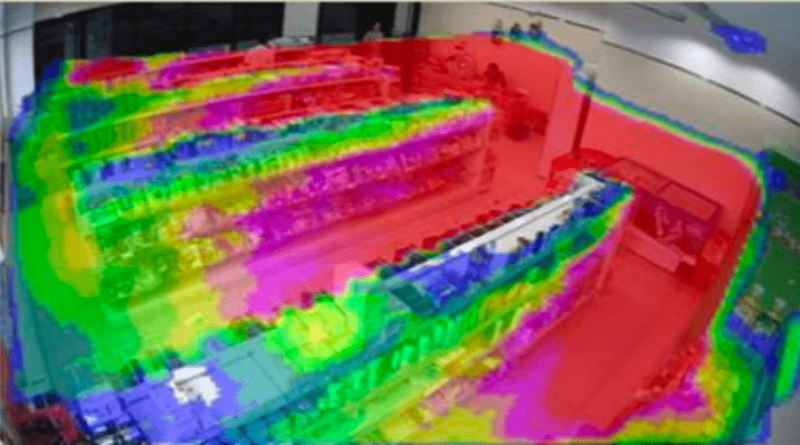
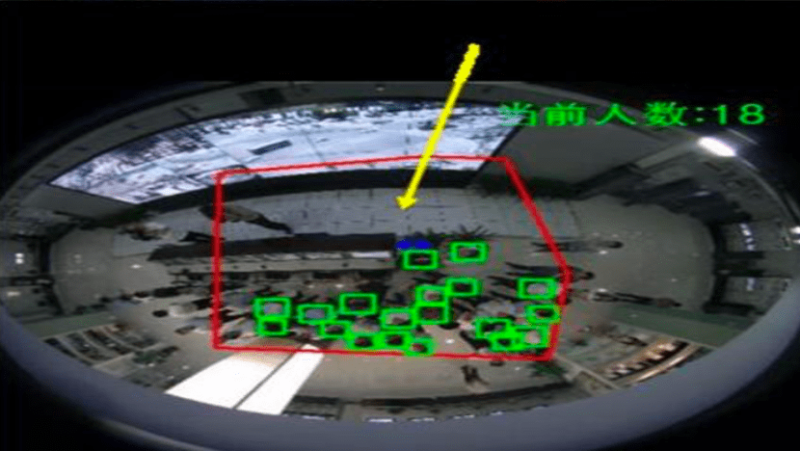
[Source: CICC and Hikvision, “AI in China’s new retail: customer traffic recognition in smart stores”]
Digitalizing offline retail
Relying on AI robots and other AI technologies in Chinese retail empowers offline stores to adopt digital management
Traditional large-scale retail chains need to manage hundreds of stores across the country. By deploying Dahua’s smart retail solution, offline retailing stores can implement precision marketing, find the stores with poor sales, and even identify theft through reviewing business data. Also, the remote patrol function can be used to directly view the status of each store, in terms of its operation, display, health, service, and compare the high and low performing stores in real-time. The face recognition among AI technologies in Chinese retail accurately counts the consumer traffic data and combines the sales data to analyze effectiveness and customer preference.

Supply chain and logistics optimization
Increased usage of AI technologies in Chinese retail serves to improve overall efficiency and resolve the limitations of traditional retailers, such as inefficient planning, labor-intensive warehousing, and slow response to market changes. Under the complex network and increasingly diversified consumer demands, retailers will need an automated supply chain. AI technologies in Chinese supply chain include deep learning, machine learning, and sensor equipment. Product tags like popularity, best seller, and high margin will be categorized without human intervention. When a product is contributing relatively less compared with its resource, time, revenue, margin, it would be automatically replaced.
For a specific example, Cainiao Network has created a logistics information platform that links delivery vendors, warehouses, and merchants. The platform is designed to digitize the logistics management with AI applications in China’s new retail. Also, building on their work in smart logistic robots, Cainiao has developed an agile, automated warehouse solution. The self-charging AGV robots in the warehouse are expected to reduce manual staff labor by an average 50,000 steps per day and improve efficiency by 30%.
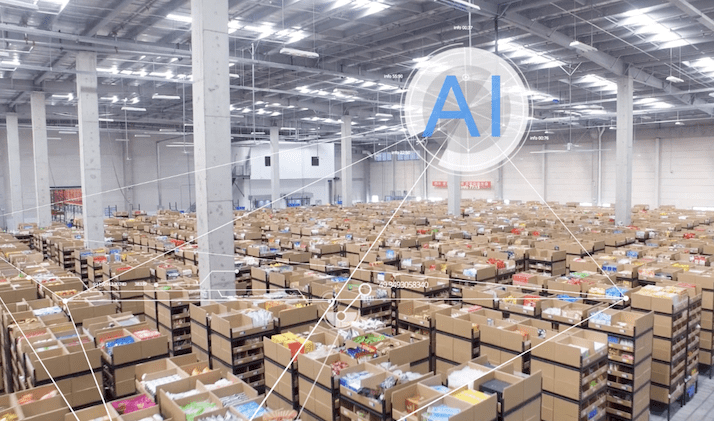
The promotion of AI in new retail in China is to further accelerate the process of new retail transformation in terms of data, networking, and intelligence. It changes the retailing landscape by creating efficient and accurate user portraits, perfect merchandise, and service, as well as the accurate decisions based on AI-led data.
Retail reform: Using AI technology in Chinese retail to center on customers’ needs
China is the first country undergoing a“new retail” reform to focus on customers’ needs. Compared to the traditional retail industry, the collection of customers information is more time-efficient. At the same time, with updated AI applications in China’s new retail, retailers are considering how to use customer data to analyze customers’ consumption behavior in the store or online in a timely manner. Therefore, customer supports have also been launched by AI in China’s new retail.
1) Smart product search and recommendations
By integrating AI in new retail, real-time data in many e-commerce channels is used to predict what consumers want. It is based on previous purchases, online browsing, comments, to achieve precise marketing. Take Taobao’s AI design system Luban as an example:
Luban system first combines big data and deep learning to decompose the original images, train and learn different designer styles; secondly, according to users’ preferences and other data matching to generate digital ads, the system selects the best ads after scoring. The system processes over 8,000 posters per second as demonstrated in the below picture:
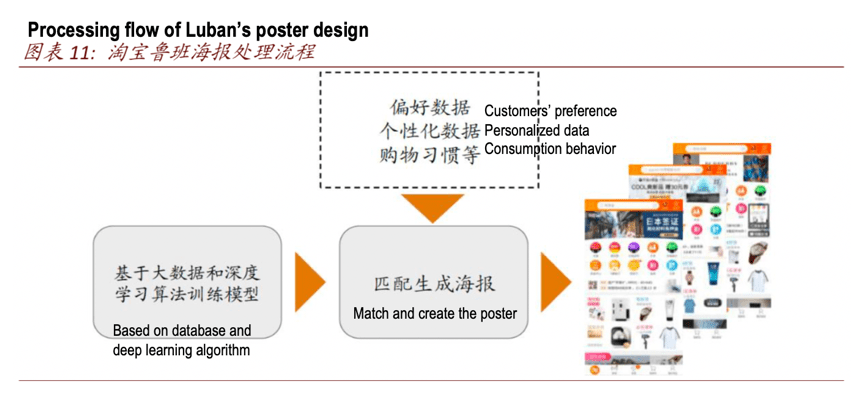
2) Smart customer service (Chatbot)
With the development of the Chinese retail industry, the needs of the online customer service are continuously growing. The data shows the market of China’s online customer service in 2017 was 64.4 billion yuan, with a compound growth rate of 10.62%. Because the traditional type of customer service has many weaknesses such as high labor cost, speech recognition is used as one of AI technologies in Chinese retail to solve problems effectively based on big data and deep learning. It is expected to gradually replace traditional manual customer service and improve the quality of service.
Ali Xiaomi (阿里小蜜) is an AI-enabled personal shopping assistant and customer service representative used on Alibaba’s e-commerce websites. With the use of natural language understanding, Ali Xiaomi stands out from other chatbot services available in China. It is able to understand customers’ messages, including texts, voice, and even photos. It will return a list of recommendations that users can choose by brand, color, and other characteristics. Also, Ali Xiaomi can answer some frequently asked questions and inquiries from consumers.

3) Pervasive personalization
Merchants selling on mainstream e-commerce platforms presently can personalize their virtual storefronts, offer real-time and tailored product recommendations based on purchase histories, demographics, and geographic locations. It is also an effective approach to center on customers and improves efficiency by integrating AI applications in China’s new retail.
Large new retail platforms using AI: the fusion of algorithms and experience
Currently, AI is widely implemented in hypermarkets, supermarkets, and also convenience stores. Apart from such retailing stores, other internet companies like Tencent are also the leading buyer and contributor to developing related AI applications. Thanks to the promotion of retail giants, such as Alibaba, JD.com, Suning, etc., AI applications in China’s new retail are on the rise will continue to expand over the next two years.
1) Hypermarket: Ali & Hema, JD & 7Fresh
Hema and 7Fresh are both highly integrated their online and offline markets. They provide services that connect supermarkets and restaurants. Users add products to their digital cart by scanning QR codes. JD also launched the unmanned shopping cart service, which supported by image recognition. In addition, combined with the no cash payment method, Ali and JD can obtain accurate data of users, in turn, to achieve precise marketing.
The availability of electronic price tags that can be recognized by machine learning applications like RFID, is the key to the efficient operation of hypermarkets. Hence electronic price tags are a key AI technology in Chinese retail. The use of electronic price tags ensures the same price online and offline sales. Furthermore, with the mobile handheld identification devices, staff use codes to identify which goods to pick from shelves, then package the products and transport them to the express delivery department. The efficient data transmission chain is also important to support for their delivery commitment, as well as to helping expand the customer base.
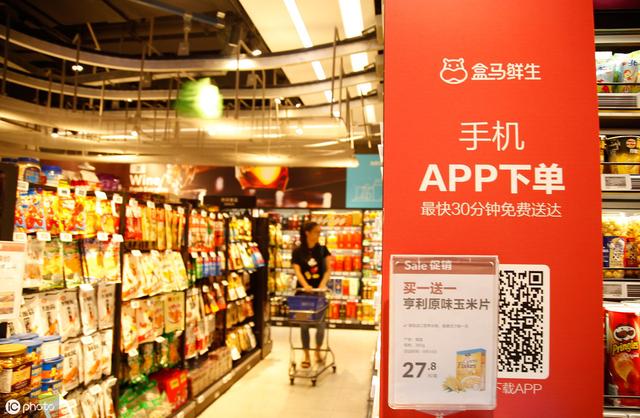
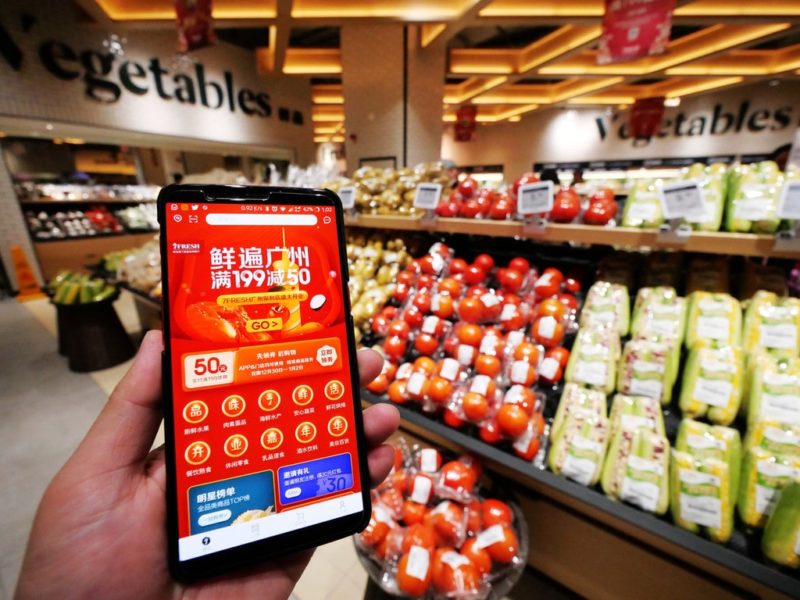
2) AI + big data: Tencent & You Mall smart retail system (优mall)
Tencent’s Mall Smart retail system was released in 2017. It is equipped with Tencent’s AI technologies called Youtu, and Tencent’s Cloud Data. The system includes VIP-to-store reminders, store compasses, line analysis, customer group management, facial recognition payment, etc., covering the various sections of the store. Youtu’s facial recognition technology is applied to customer identification; shelves display adjustment, shopping guide, and patrol shop functions. Through the moving trajectory in the mall, shopping paths, and correlations between categories and commodities can be recorded and analyzed to optimize the arrangement of shopping malls. The following chart shows the central values of the AI system in digitalizing customers’ information analysis:
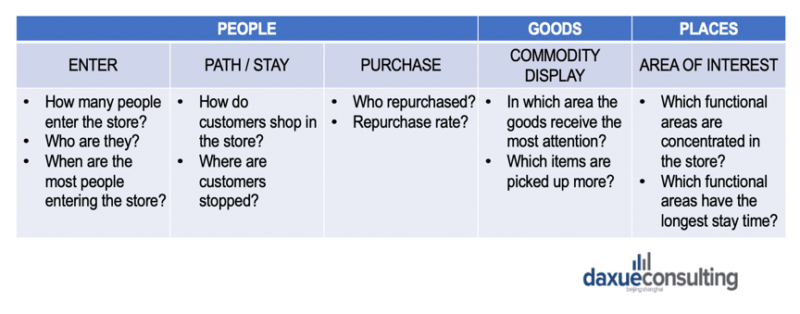
In short, AI in China’s new retail indeed has great potential for continuous development. Whether in the hypermarket, the smart retail system, or any new forms that may emerge in the future, the fusion of algorithm and experience is an important factor for retailers to consider when deploying AI. That means it is necessary to combine advanced algorithms of AI technologies in Chinese retail with customers sentiments from the previous retail experience.
What AI technologies in China can bring to your retail shop?
Currently, the main players of AI in new retail in China can be sorted into three categories: cloud services, large retailers with AI uses, and AI companies.
Based on their own database, large internet companies can develop or integrate AI technologies internally. The represented companies are Alibaba, Tencent, and Baidu. AI companies in China can deliver customized technology that addresses individual store needs. Apart from AI technology, relatively small retailers can also learn from large and mature retailers to find AI solutions.
The structure of leading players of AI in new retail in China:
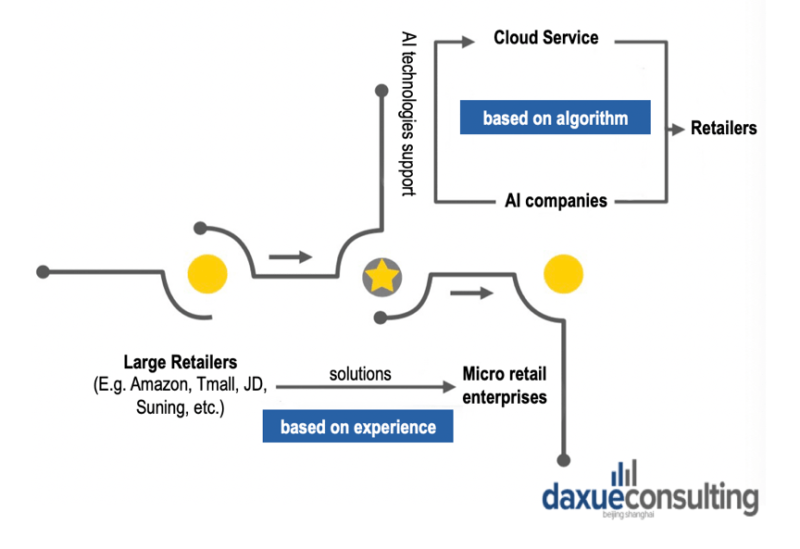
Chinese AI companies in retail are mainly focusing on the technology layer. For example, Malong Technologies provides computer vision service. Some other companies like Megvii, Deepglint, Extreme Vision are also offering AI applications to cover the overall retail chain in China.
Therefore, for the foreign retailers who want to launch or further develop their business and integrate AI in China, cooperating with AI technologies companies is considered as an essential and practical approach to target more Chinese consumers.
Based on the algorithms, there are two segments of technologies that foreign retailers can use to find partners in AI and China’s new retail.
Firstly, in the basic level, it is suggested for those retailers with a market share in China to partner with the AI companies which are serving cloud, data, and algorithms technologies. They can integrate AI in new retail to form their own consumer group portraits and analyze their preferences and expectations through the data analysis services. Here is the list of companies which are providing cloud, data, and algorithms services:

On the other hand, China’s AI companies in technology may bring more solutions to the current retail bottleneck. With applications such as computer vision, intelligent speech, and natural language processing, retail companies can directly target the consumers and reduce costs by more intelligent customer services and improved shopping experience.AI companies in China who are developing this type of technology are below:

In conclusion, an innovative retailer should use AI to make accurate forecasts and anticipate the future. AI in China’s new retail is more expansive than just unmanned stores, also reaching into the territory of hypermarkets and supermarkets, and other retail methods that are yet to be invented. In this world of big data, insights from AI will contribute to creating competitive advantages for retailers to improve the efficiency and profitability within the Chinese retail industry.
Author: Yufeng GUO
Learn more about China’s Artificial Intelligence ecosystem by reading our AI in China White Paper.



